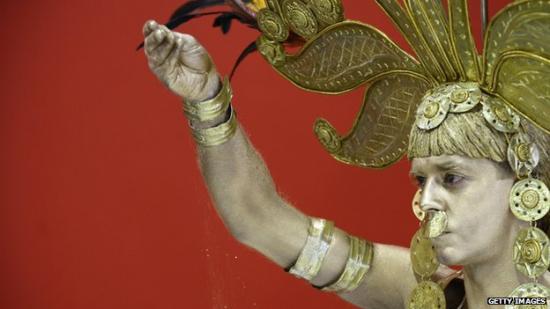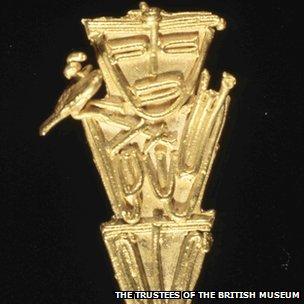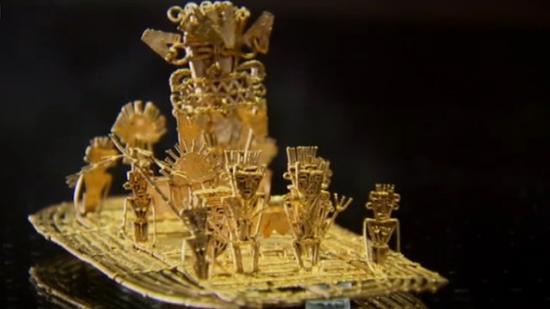Dr Jago Cooper - Curator of the Americas, the British Museum
Source - http://www.bbc.co.uk/news/magazine-20964114

The dream of El Dorado, a lost city of gold, led many a conquistador on a fruitless trek into the rainforests and mountains of South America. But it was all wishful thinking. The "golden one" was actually not a place but a person - as recent archaeological research confirms.
Columbus's arrival in the Americas in AD1492 was the first chapter in a world-changing clash of cultures. It was a brutal confrontation of completely opposing ways of living and systems of beliefs.
The European myth that arose of El Dorado, as a lost city of gold waiting for discovery by an adventurous conqueror, encapsulates the Europeans' endless thirst for gold and their unerring drive to exploit these new lands for their monetary value.
The South American myth of El Dorado, on the other hand, reveals the true nature of the territory and the people who lived there. For them, El Dorado was never a place, but a ruler so rich that he allegedly covered himself in gold from head to toe each morning and washed it off in a sacred lake each evening.

Jago Cooper (r) found ancient traditions were kept alive at Lake Guatavita by Enrique Gonzalez (l)
The real story behind the myth has slowly been pieced together over recent years using a combination of early historical texts and new archaeological research.
At its heart is a true story of a rite of passage ceremony carried out by the Muisca peoples who have lived in Central Colombia from AD800 to the modern day.
Different Spanish chroniclers arriving in this alien continent in the early 16th Century began to write about this ceremony of El Dorado, and one of the best accounts comes from Juan Rodriguez Freyle.
In Freyle's book, The Conquest and Discovery of the New Kingdom of Granada, published in 1636, he tells us that when a leader died within Muisca society the process of succession for the chosen "golden one" would unfold. The selected new leader of the community, commonly the nephew of the previous chief, would go through a long initiation process culminating in the final act of paddling out on a raft onto a sacred lake, such as Lake Guatavita in Central Colombia.
Surrounded by the four highest priests adorned with feathers, gold crowns and body ornaments, the leader, naked but for a covering of gold dust, would set out to make an offering of gold objects, emeralds and other precious objects to the gods by throwing them into the lake.
The shores of the circular lake were filled with richly adorned spectators playing musical instruments and burning fires that almost blocked out the daylight from this crucible-like lake basin. The raft itself had four burning fires on it throwing up plumes of incense into the sky. When at the very centre of the lake, the priest would raise a flag to draw silence from the crowd. This moment would mark the point at which the crowds would commit allegiance to their new leader by shouting their approval from the lakeshore.
Fascinatingly, many aspects of this interpretation of events have been validated by painstaking archaeological research - research that also reveals the exceptional skill and scale of gold production in Colombia at the time of European arrival in 1537.

Tunjos or offerings to the gods were left in sacred places like lakes and caves
Within Muisca society gold, or the more specifically an alloy of gold, silver and copper called tumbaga, was highly sought after, not for its material value but for its spiritual power, its connection to the deities and its ability to bring balance and harmony within Muisca society. As Muisca descendant Enrique Gonzalez explains, gold does not symbolise prosperity to his people.
"For the Muisca of today, just as for our ancestors, gold is nothing more than an offering... gold does not represent wealth to us."
Recent research by Maria Alicia Uribe Villegas from the Museo Del Oro in Bogota and Marcos Martinon-Torres from UCL Institute of Archaeology has shown that within Muisca society these "gold" objects were made specifically for immediate use as offerings to the gods to encourage them to balance the equilibrium of the cosmos and ensure a stable relationship with their environment.
According to archaeologist Roberto Lleras Perez, an expert on Muisca gold working and belief systems, the creation and use for Muisca metalwork was distinct in South America.
"No other society, as far as I know, dedicated over 50% of their production for votive offerings. I think it is quite unique," he says
The gold objects, like the collection of tunjos (votive offerings, most commonly flat, anthropomorphic figures) on digital display at the British Museum, were made by using the "lost wax" process - creating clay moulds around delicate wax models before melting them and casting them in gold.
Since all the gold objects in each offering have the same chemical signature as well as unique manufacture traits, it is clear these objects were being specifically made for this offering and may only have been in existence for a matter of hours or days before being deposited.
Incredibly, a gold raft depicting a scene exactly like that described by Juan Rodriguez Freyle was found in 1969 by three villagers in a small cave in the hills just to the south of Bogota. This scene of a man covered in gold going out into a sacred lake, such as Lake Guatavita, is the real story of El Dorado.

The Muisca Raft is on display at the Gold Museum in Bogota
The way this story grew into the myth of a legendary city of gold reveals the distinct way in which gold was a source of material wealth for European conquerors. They had little understanding of its true value within Muisca society. European minds were simply dazzled by just how much gold must have been thrown down into the deep waters of the lake and buried at other sacred sites around Colombia.
In AD1537 it was these stories of El Dorado that drew the Spanish conquistador Jimenez de Quesada and his army of 800 men away from their mission to find an overland route to Peru and up into the Andean homeland of the Muisca for the first time.
Quesada and his men were lured ever deeper into alien and inhospitable territories where many lost their lives. But what Quesada and his men found astounded them, as the goldworking of the Muisca was like nothing they had ever seen before. The exquisitely crafted gold objects used techniques beyond anything ever seen by European eyes.
Tragically, the desperate hunt for gold is still very much alive. Archaeologists, working at fantastic research institutions like the Museo del Oro in Bogota, are fighting against a rising tide of looting. So just like the European conquistadors of the 16th Century their modern counterparts continue to ravage South America's past and rob us of the fascinating stories behind it.
The quantities of gold uncovered by these looters is still astounding. In the 1970s when new sites were discovered by looters in northern Colombia it caused the world gold market to crash.
This El Dorado-inspired looting of gold has meant that the vast majority of precious pre-Columbian gold objects have been melted down and the real value of these artefacts as clues to the workings of an ancient culture have been lost forever.
Fortunately, surviving collections of objects curated at the Museo del Oro in Bogota and British Museum in London can provide an insight into these different perspectives on material value and human perception and most importantly tell the true story behind the myths of El Dorado.
Chasing the dream of a land of gold
- AD800 Muisca culture begins to flourish in modern-day central Colombia, one of many cultures to develop exceptional gold working traditions in South America
- 1532 Francisco Pizarro arrives in Peru to start the first of three attempts to conquer the Inca and colonise South America recovering large quantities of gold as he does
- 1537 Jimenez de Quesada explores Muisca territory for the first time
- 1541 Francisco de Orellana is the first European to travel down the length of the Amazon river, allegedly inspired by a search for El Dorado
- 1594 Sir Walter Raleigh makes the first of two expeditions in search of El Dorado, the second accompanied by his son Watt who was killed during the adventure in AD1617
- 1772 Scientist Alexander von Humboldt and botanist Aimé Bonpland travel to South America to once and for all prove or dispel the myth of El Dorado. They return to Europe and spread widely their believed conclusion that El Dorado had been nothing but a dream of the early conquistadors
Leonora Duncan, the British Museum